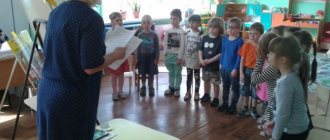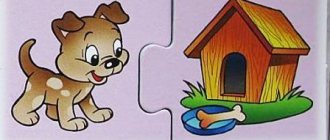Self-analysis on the applique. Topic “Scarf for Tanya”
GCD Self-Analysis
with children of the second youngest group.
Topic: “Scarf for Tanya”
Integration of educational areas:
“Artistic and aesthetic”, “Speech development”
Target
: teach children to apply previously acquired knowledge and skills and apply them in practice.
Tasks:
Educational
: learn how to stick ready-made figures on your own, lay out the future pattern.
Educational:
develop the ability to hold a brush correctly, imagination, thinking, fine motor skills, knowledge of colors (red, green, yellow)
Educational:
cultivate responsiveness, accuracy when doing work, and interest in creative activities.
Types of children's activities:
educational, playful, communicative.
Materials
: album sheets (square), glue, brushes, napkins, ready-made figures (triangles, squares, circles), sample, stands for brushes, Tanya doll.
Methods and techniques:
—
Surprise moment.
-Creation of a game situation, artistic expression.
-Finger gymnastics
-Help from the teacher: questions, demonstration, praise.
The lesson was carried out in accordance with the notes. The summary is taken in accordance with the objectives of the main educational program “From birth to school”, corresponding to the given age of children. To implement the task, techniques were selected that help solve software problems in an interesting way.
Introductory part: organization of children, motivation for upcoming activities. At the organized stage of the GCD, the problem-situational method was used. The children were asked to help Tanya. For the lesson, it was proposed to read Agnia Barto’s poem “Ball”,
The main part was a special organization and independent activity of children aimed at solving the problem.
The final part summarized the activities. She reinforced the positive results of the session with verbal encouragement.
When working with children, I used conversation, artistic expression, questions for children to test their intelligence and logical thinking - all this contributed to the effectiveness of the educational activity.
At NOD I used the following forms of work: frontal, individual, group.
Throughout the entire NOD, I tried to maintain children's cognitive interest through emotional and expressive speech. Addressing children. I used accessible questions. I believe that the goal I set has been achieved, the tasks have been accomplished.
Self-analysis was compiled by teacher Asanova Z.R.
Head of MDOU Matveeva L.O.
"May kindergarten "Solnyshko"
Romanova Vitalina Anatolyevna, teacher of MBDOU kindergarten No. 10 “Lazorik” in the city of Donetsk, Rostov regionIntrospection
experimental activities with children of the second younger group
"Introduction to the properties of water"
The educational activity was carried out during the time allotted in the daily routine, 7 children were present. The children of the group have developed skills in educational activities, they easily make contact with the teacher. They know how to hear and listen to the teacher. The educational activity was carried out in accordance with the outline, in drawing up which, I first of all took into account the age, psychological and individual characteristics of the children, outlined the goal, objectives, and content of the educational activity, determined the form of implementation, methods and techniques necessary to obtain positive results. OOD was built in the form of experimental research activities for children, which contains the integration of educational areas: “Speech development”, “Cognitive development”, “Social and communicative”.
The purpose of educational activities is to activate mental abilities, logical thinking, creativity of children, and the ability to draw conclusions.
Tasks:
Educational: develop dialogical, monologue speech of children, enrich vocabulary with words denoting the properties of water.
Developmental: to promote the development of children's cognitive activity, curiosity, desire for independent knowledge and reflection.
The logic of constructing the OOD allowed it to be carried out within the allotted time. The duration of the OOD is 15 minutes, which corresponds to the standards of SAN PiN.
Analyzing the children’s activities, I would like to note that they showed cognitive activity throughout the entire time and reacted emotionally to methods of activating activities. They were interested, attentive, organized, felt comfortable, and were relaxed. The questions (tasks) offered to the children, to which they themselves found the answer, drew appropriate conclusions, encouraged the children to take action and solve the assigned problems. I believe that the chosen form of organizing the OOD was quite effective, which made it possible to see the final result in specific activities. The effectiveness of OOD was also facilitated by preliminary work (children used existing knowledge and skills) carried out in the group, namely: constant observations of rain and snow during walks at different times of the year, observation of how evaporation occurs after rain in active sunlight, conducting experiments with water, snow, ice, looking at snowflakes, decorating ice buildings with colored pieces of ice, reading fiction, solving riddles, using folk signs in practice, etc. The interconnection and interdependence of OOD elements and the implementation of practical tasks helped create a positive emotional background of the activity process and maintain interest throughout the entire time. The proposed tasks were accessible in complexity to the children, which contributed to the solution of the assigned tasks, the children felt like “creators”, were happy, surprised, admired, willingly shared their discoveries with the teacher and their friends, and this made it possible to develop their positive self-esteem and self-worth: “U I succeeded!”, “I know,” etc. The children were friendly, responsive, and helped each other. At every moment of educational activities, I tried (while being nearby) to quietly guide the children to find a problem, helped them gain new experience, the specifics of working with children were reflected in a person-oriented, differentiated approach to learning, expressed in the performance of tasks of different levels of complexity, taking into account the level of knowledge and “ zone of proximal development" of each child. Individualization of training was manifested in providing assistance, reminders, and additional explanations to those who had difficulty performing experiments. The children were constantly praised and encouraged in order to consolidate their situation of success. Changing activities (experiments, experimenting, guessing riddles, reading poetry, dynamic pause) helped prevent fatigue. The manuals were of sufficient size, bright, colorful, and selected at a level accessible to children. She used visual, verbal and practical methods that were aimed at using cognitive, speech, motor skills and abilities, improving them, and developing attention, imagination, memory, speech. The children were pleased with the fact that they constantly showed curiosity, were interested in cause-and-effect relationships, tried to independently come up with explanations, and were able to observe and experiment. They have basic knowledge about the natural and social world, are capable of making their own decisions, and are prone to volitional efforts. They have a fairly good command of oral speech and can express their thoughts and desires using speech. The program tasks were solved, OOD achieved its goal.




